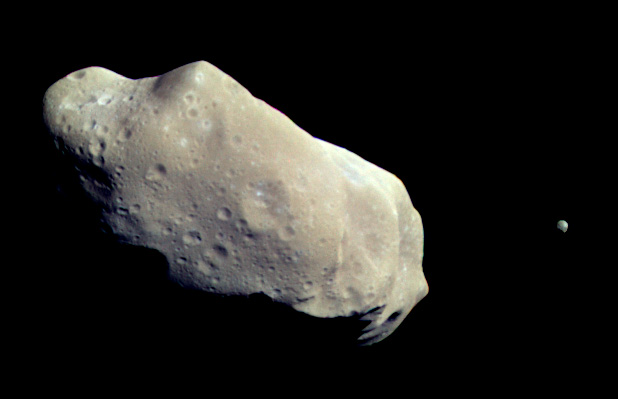243_ida_crop.jpg (618 × 399 pixels, file size: 50 KB, MIME type: image/jpeg)
File history
Click on a date/time to view the file as it appeared at that time.
| Date/Time | Thumbnail | Dimensions | User | Comment | |
|---|---|---|---|---|---|
| current | 05:02, 26 March 2009 |  | 618 × 399 (50 KB) | Chzz | {{Information |Description=This color picture is made from images taken by the imaging system on the Galileo spacecraft about 14 minutes before its closest approach to asteroid 243 Ida on August 28, 1993. The range from the spacecraft was about 10,500 kil |
File usage
More than 100 pages use this file. The following list shows the first 100 pages that use this file only. A full list is available.
- 243 Ida
- Ariel (moon)
- Asteroid
- Asteroid belt
- Belinda (moon)
- Bianca (moon)
- Binary asteroid
- CONTOUR
- Caliban (moon)
- Callisto (moon)
- Charon (moon)
- Clementine (spacecraft)
- Comet Rendezvous Asteroid Flyby
- Cordelia (moon)
- Cressida (moon)
- Cupid (moon)
- Dactyl (moon)
- Dawn (spacecraft)
- Deep Impact (spacecraft)
- Deep Space 1
- Deimos (moon)
- Desdemona (moon)
- Despina (moon)
- Dione (moon)
- Enceladus
- Epimetheus (moon)
- Europa (moon)
- Extraterrestrial sky
- Fenrir (moon)
- Ferdinand (moon)
- Fornjot (moon)
- Francisco (moon)
- Galatea (moon)
- Galilean moons
- Galileo project
- Ganymede (moon)
- Giotto (spacecraft)
- Halimede (moon)
- Hati (moon)
- Hayabusa
- Hyperion (moon)
- Iapetus (moon)
- Icy moon
- Io (moon)
- Juliet (moon)
- Laomedeia
- Larissa (moon)
- List of natural satellites
- Mab (moon)
- Margaret (moon)
- Minor-planet moon
- Miranda (moon)
- Moon
- Moons of Jupiter
- Moons of Mars
- Moons of Neptune
- Moons of Saturn
- Moons of Uranus
- Mundilfari (moon)
- NEAR Shoemaker
- Naiad (moon)
- Naming of moons
- Natural satellite
- Nereid (moon)
- New Horizons
- Oberon (moon)
- Ophelia (moon)
- Perdita (moon)
- Philae (spacecraft)
- Phobos (moon)
- Phoebe (moon)
- Portia (moon)
- Prospero (moon)
- Proteus (moon)
- Psamathe (moon)
- Puck (moon)
- Rhea (moon)
- Rosalind (moon)
- Rosetta (spacecraft)
- S/2004 S 13
- S/2004 S 17
- Sakigake
- Sao (moon)
- Setebos (moon)
- Stardust (spacecraft)
- Stephano (moon)
- Suisei (spacecraft)
- Sycorax (moon)
- Tethys (moon)
- Thalassa (moon)
- Timeline of Rosetta (spacecraft)
- Timeline of discovery of Solar System planets and their moons
- Titan (moon)
- Titania (moon)
- Trinculo (moon)
- Triton (moon)
- Ulysses (spacecraft)
- Umbriel (moon)
- Vega 1
- Vega 2
View more links to this file.
Global file usage
The following other wikis use this file:
- Usage on ar.wikipedia.org
- كويكب
- بوابة:علم الفلك/مقالة مختارة
- بوابة:المجموعة الشمسية/مقالة متميزة
- 243 إيدا
- ويكيبيديا:مقالة الصفحة الرئيسية الجيدة/482
- بوابة:علم الفلك/مقالة مختارة/25
- قائمة الكواكب الصغيرة والمذنبات التي زارتها مركبات فضائية
- بوابة:المجموعة الشمسية/مقالة متميزة/11
- قمر كويكبي
- بوابة:كواكب صغيرة ومذنبات
- بوابة:كواكب صغيرة ومذنبات/مقالة مختارة
- بوابة:كواكب صغيرة ومذنبات/مقالة مختارة/1
- Usage on arz.wikipedia.org
- Usage on ast.wikipedia.org
- Usage on az.wikipedia.org
- Usage on beta.wikiversity.org
- Usage on bn.wikibooks.org
- Usage on br.wikipedia.org
- Usage on bs.wikibooks.org
- Usage on ca.wikipedia.org
- Usage on ce.wikipedia.org
- Usage on ckb.wikipedia.org
- Usage on da.wikipedia.org
- Usage on el.wikipedia.org
- Usage on en.wikibooks.org
- Usage on en.wikiversity.org
- Draft:Original research/Radiation astronomy
- User:Marshallsumter/Radiation astronomy1/Planets/Sciences
- User:Marshallsumter/Radiation astronomy/Blues
- User:Marshallsumter/Radiation astronomy2/Reds
- User:Marshallsumter/Radiation astronomy1/Objects
- User:Marshallsumter/Rocks/Rocky objects/Astronomy
- Interplanetary medium
- User:Marshallsumter/Rocks/Rocky objects
- User:Marshallsumter/Rocks/Rocky objects/Asteroids
- User:Marshallsumter/Radiation astronomy/Absorptions
- User:Marshallsumter/Radiation astronomy2/Rocks
- User:Marshallsumter/Radiation astronomy/Asteroids
- User:Marshallsumter/Radiation astronomy1/Particles
- Radiation/Astronomy
- Usage on en.wiktionary.org
View more global usage of this file.



